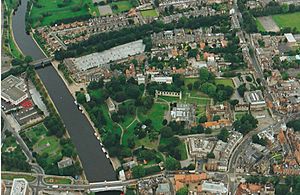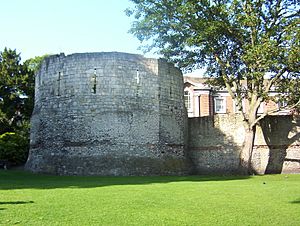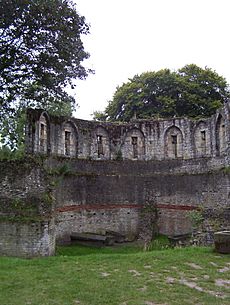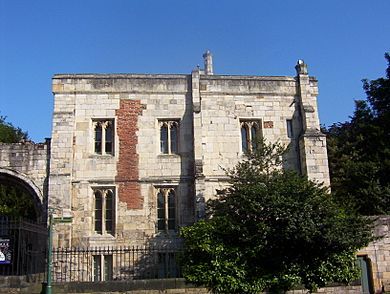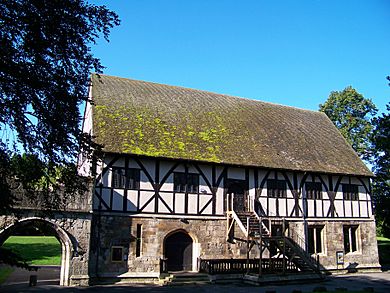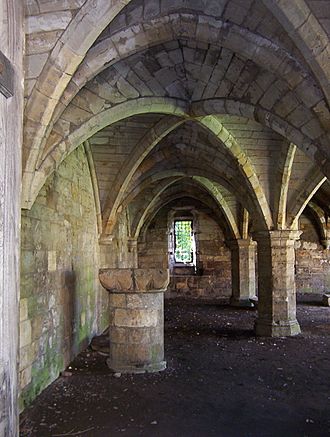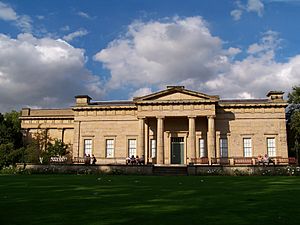York Museum Gardens facts for kids
Quick facts for kids Museum Gardens |
|
|---|---|
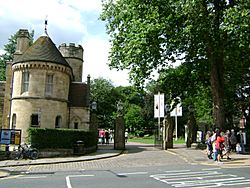
Main Gates and lodge house of York Museum Gardens
|
|
| Location | York, England |
| Area | 10 acres (0.040 km2) |
| Created | 1835 |
| Operated by | York Museums Trust |
| Visitors | 1,651,508 (2019–2020) |
| Status | Open 7 days a week, 10:30 am to 6 pm. |
| Website | http://www.yorkmuseumgardens.org.uk/ |
The York Museum Gardens are beautiful botanic gardens in the heart of York, England. They are located right next to the River Ouse. These gardens cover about 10 acres (which is like 7 football fields!) and were once part of the old St Mary's Abbey. They were created in the 1830s by a group called the Yorkshire Philosophical Society. The Yorkshire Museum, which is also in the gardens, was built by them too.
Today, the City of York Council looks after the gardens, and the York Museums Trust manages them. A famous landscape architect named Sir John Murray Naysmith designed the gardens to have many different kinds of plants, trees, and birds. It's free to enter the gardens, and lots of fun things happen there, like outdoor plays and festivals.
The gardens are also home to many old buildings. You can see parts of a Roman fort called Eboracum, including the Multangular Tower and pieces of the Roman walls. There's also the Anglian Tower, which was probably built into an even older Roman fortress. During the Middle Ages, these Roman walls became part of York's city walls. Most of the other old buildings are from St Mary's Abbey, like the ruins of the abbey church and the Hospitium. You can also find parts of St. Leonard's Hospital chapel. In the 1800s, the Yorkshire Philosophical Society built more buildings, including the Yorkshire Museum and its round observatory. The museum has amazing collections about biology, geology, archaeology, and astronomy.
Contents
Discovering the History of York Museum Gardens
The York Museum Gardens have a long and interesting past.
How the Gardens Began
The Royal Family gave the land for the gardens to the Yorkshire Philosophical Society in 1828. The society wanted to build a museum for their collections, and the Yorkshire Museum was finished in 1830. The land was given on one condition: that they would create a botanical garden there. So, the gardens were designed in the 1830s by landscape architect Sir John Murray Naysmith.
When they first opened in 1835, the gardens had a greenhouse, a pond, and even a small zoo! But the zoo didn't last long because a bear escaped and caused a bit of a stir. Princess Victoria herself visited the gardens in 1835. By 1854, people were calling the gardens "one of the main attractions of York." Back then, it cost a small fee to get in, unless you were a member.
Who Manages the Gardens Today?
In 1960, the gardens and the Yorkshire Museum were given to the City of York Council, making them a public park for everyone to enjoy. Since 2002, the York Museums Trust has been in charge of the gardens, along with other cool places like York Castle Museum and York Art Gallery. Students from Askham Bryan College of Agriculture help keep the gardens looking beautiful.
Exploring York Museum Gardens
York Museum Gardens cover 10 acres (about 4 hectares) on the north side of the River Ouse. They are just outside the city walls in central York.
How to Enter the Gardens
You can get into the gardens from four different places:
- On Marygate (near St Olave's Church)
- On Museum Street (near Lendal Bridge)
- Through a path next to King's Manor
- From the path along the river
The gardens gently slope down towards the river. They have old buildings, grassy areas, and lots of plants and trees. The gardens are open during the day, but the exact times change with the seasons. It's usually free to get in, but some special events might have a charge. About 1.3 million people visit the gardens every year! Just remember, you can't ride bikes or play ball games inside.
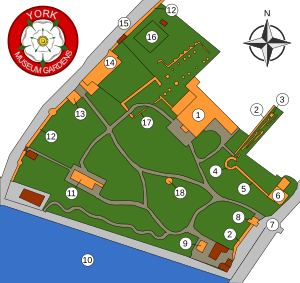
Plants in the Gardens
The gardens are home to about 4,500 different plants and trees. Some are native to England, while others come from all over the world. You'll see big beds filled with shrubs and trees, and open lawns with individual trees. There's a cool monkey puzzle tree, plus oak and chestnut trees. Six trees in the gardens are even called "county champion trees" because they are so special!
Near the Marygate entrance, by the old abbey ruins, there's a pretty rockery. In front of the Yorkshire Museum, you'll find a terrace with beds of white roses, which are the symbol of Yorkshire. There's also an "Edible Wood" behind the York Art Gallery. It was planted in 2015 and has plants that you can eat, which are both beautiful and useful!
Animals in the Gardens
Long ago, in the early 1800s, the gardens had a small zoo with a bear, an eagle, and monkeys. But in 1831, a bear got loose and chased the museum's keeper, John Phillips, and Reverend Harcourt! The bear was later sent to London Zoo.
Today, the gardens are home to many semi-tame grey squirrels and lots of different birds. You might spot Common wood pigeons, Blue tits, robins, and blackbirds. Until 2006, a family of peacocks lived there for over 70 years!
The gardens are also a special place for the endangered Tansy beetle. Since 2012, they've been a release site for these beetles, and it's one of the best places to see them in the wild. In 2018, a new type of leaf-mining fly, called Phytomyza scotina, was found here!
Geology of the Gardens
Near the main gates, you can see a large pink granite boulder. This stone isn't from York! It was carried here from Shap in Cumbria by glaciers during the last ice age. In 2015, a special mosaic map was made for the gardens. It shows the different types of rock found in Yorkshire, using pebbles of the actual stones. This map celebrates the 200th anniversary of the first geological map of Britain by William Smith.
Events and Activities in the Gardens
The gardens are a popular spot for both locals and visitors. They host many special events.
Performances and Festivals
You can often find open-air theatre and music performances here. In the 1970s, famous bands like Roxy Music and Hawkwind played concerts in the gardens. The York Mystery Plays, which are very old plays, have been performed among the ruins of St. Mary's Abbey. Even famous actress Dame Judi Dench acted in these plays in the gardens when she was young! The Mystery Plays returned in 2012 with over a thousand local volunteers.
The gardens also host cultural celebrations. In 2006, hundreds of people celebrated Chinese New Year with lion dancers. The Eboracum Roman Festival has been an annual event since 2016, celebrating Roman history. In 2019, the gardens hosted the York Proms, an outdoor classical music concert.
Saluting Station
The gardens are home to York's Saluting Station, one of only 12 in the whole United Kingdom! Here, 21-gun salutes are fired at noon to celebrate important events for the British Royal Family. A military band marches to the gardens before the salute. For example, a 96-gun salute was held in 2022 to remember Queen Elizabeth II (one for each year of her life).
Art Exhibitions
There's a special "Artist's Garden" behind the Art Gallery where outdoor sculptures are shown. Past exhibitions have included:
- Foundation Myths by Charles Holland (2016–2017)
- Leisureland Golf by Doug Fishbourne (2017), which was a playable crazy-golf course!
- The Pollinarium (2018), a timber structure covered with flowering plants.
- Michael Lyons: Ancient and Modern (2019–2020), a large display of sculptures.
- Ghosts in the Garden (2022), featuring wire-mesh sculptures of historical figures.
Historic Buildings in the Gardens
The gardens are filled with amazing old buildings, some dating back thousands of years!
Roman Buildings
In the northeast part of the gardens, you can see parts of the old Roman fort of Eboracum. The first defenses were built by the Ninth Legion around 71–74 AD. Later, these were replaced with strong limestone walls and towers. These stone defenses are some of the few Roman remains you can still see above ground in York.
Multangular Tower
The Multangular Tower is the western corner tower of the Roman fortress. It has 10 sides, which is where its name "multangular" comes from. It's about 19 feet (5.8 meters) high. It was built in the early 4th century and had three floors, possibly to hold a catapult. Inside the tower, you can see five Roman stone coffins that were brought from other parts of York.
Roman Walls
A 76-foot (23-meter) section of a 4th-century wall connects the Multangular Tower to a smaller tower. The side of the wall facing the gardens is carefully built, because it was meant to be seen. The other side is rougher because it was covered by an earth bank. These walls were used even after the Roman period ended and became part of the medieval city walls. During the English Civil War, a cannonball even made a hole in the wall near the Multangular Tower! The Roman parts of the wall are made of rectangular limestone blocks with a band of red tile. Later medieval additions use bigger blocks and have cross-shaped arrow slits.
Anglian Tower
North of the Multangular Tower, you'll find a section of the medieval city wall with the original Roman wall running next to it. The stone Anglian Tower is built into this part of the wall. It was once thought to be from the time of Edwin of Northumbria, but now experts believe it's from the very late Roman period. Behind the Anglian Tower, you can see banks that show how the defenses looked during Roman, early medieval, Norman, and late medieval times.
Medieval Buildings
The gardens have several buildings from the medieval period, mostly connected to St Mary's Abbey.
St Mary's Abbey Church Ruins
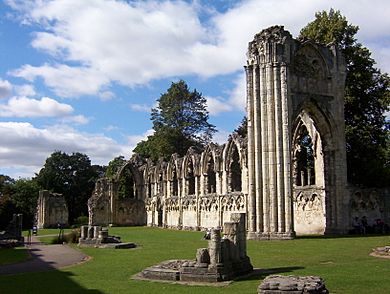
St Mary's Abbey started in 1086. A larger church was built in a Romanesque style in 1089, and then replaced by a Gothic style church between 1270 and 1279. This abbey became the richest monastery in northern England! But in 1539, King Henry VIII closed it down. Over the next 200 years, the abbey fell apart, and much of its stone was taken away.
You can still see stones from the abbey church along paths in the gardens. The main ruins are on the western side. The church was built on a slight angle because of the shape of the land. Parts of the north and west walls, built in the Gothic style, are still standing. You can see lancet windows and fancy stone patterns. The stone carvings on the columns are worn, but you can still make out plant designs. You can also see the foundations of the church and its older Norman version in the grass. Many items found here, like life-sized statues of saints, are now in the Yorkshire Museum.
St Mary's Lodge
St Mary's Lodge was built around 1470. It was part of the gatehouse at the main entrance to the abbey (now the Marygate entrance to the gardens). You can still see parts of the 12th-century gatehouse, like the archway next to the lodge. The lodge is made of stone. It's a very important building, listed as Grade I, meaning it's of outstanding interest.
The lodge might have been a guesthouse for the abbey, or a place where poor people could get help. After the abbey closed, it became a courthouse until 1722. Later, part of it was a pub! In 1840, John Philips, the museum's curator, made it his home. Today, it's the main office for the York Museums Trust.
Abbey Precinct Walls
Along with the lodge, some of the abbey's precinct walls are still standing. A section runs along the northwest part of the gardens and continues along Marygate. These walls were built in 1266 and made taller in 1318. They used to have a defensive ditch outside them. The walls include several towers and were used to protect the abbey, even playing a role in the defense of York during the siege of York.
The Hospitium
The Hospitium is located between the ruins of St Mary's Abbey Church and the River Ouse. It was probably a guesthouse for visitors to the abbey who weren't of high social rank, or maybe even a barn. It was part of a group of abbey buildings that included a brew-house, stables, and a school. The oldest parts of the ground floor were built around 1300, but the upper floor has been fixed up a lot more recently. The ruined gateway next to it is from the 15th century.
St Leonard's Hospital Undercroft
The remains of St. Leonard's Hospital chapel and undercroft are on the east side of the gardens, near the Museum Street entrance. This hospital was the biggest in England during the Middle Ages! It was run by a group of men and women from the Augustinian order. In the 14th century, it could hold up to 240 patients. St. Leonard's Hospital also closed during the dissolution of the monasteries.
The undercroft and chapel were part of the hospital's infirmary, built between 1225 and 1250. You can go inside the undercroft from the gardens. It has a rib vaulted ceiling and displays a collection of Roman and medieval stonework. In 1999, the hospital area was featured on the British TV show Time Team.
Between the Museum Street entrance and the River Ouse, you'll find a short section of York's city walls, which ends at the medieval Lendal Tower.
Buildings from the 19th and 20th Centuries
The Yorkshire Philosophical Society built several important buildings in the gardens during the 1800s and early 1900s.
Yorkshire Museum
The Yorkshire Museum was one of the first museums in Britain built just for that purpose! It was designed by architect William Wilkins in a Greek Revival style and opened in February 1830. In 1831, the first meeting of the British Association for the Advancement of Science was held here.
The museum has three main collections that are considered very important:
- Biology: Over 200,000 specimens, mostly insects. It has rare items like two stuffed great auks and a nearly complete skeleton of an extinct moa. You can also see remains of elephants, cave bears, and hyenas from Kirkdale Cave, dating back about 125,000 years!
- Geology: More than 112,500 rocks, minerals, and fossils. Over 100,000 are fossils, including important ones from the Carboniferous, Mesozoic, and Tertiary periods.
- Archaeology: Almost a million objects from around 500,000 BC to the 20th century. This includes the famous Coppergate Helmet found in York in 1982, and the Ormside Bowl, a beautiful example of Anglian silverwork.
The Observatory
Most of the museum's astronomy collection is kept in the round observatory in the middle of the gardens. It was built between 1832 and 1833. Its spinning roof was designed by John Smeaton, who also designed the Eddystone Lighthouse! A 4.5-inch (11 cm) telescope, built in 1850 by Thomas Cooke, was put in during the observatory's restoration in 1981. It's Yorkshire's oldest working observatory and is open to the public on Thursdays and Saturdays. The clock inside was made in 1811 and was used to set the time for other clocks in York!
Other Buildings
- Museum Gardens' Lodge: At the Museum Street entrance, this lodge was built in 1874. It's designed in a Victorian Gothic revival style. Today, it holds the offices and reading room for the Yorkshire Philosophical Society.
- Curator's House: Also called 'Manor cottage,' this house was built in 1844 for the museum's curator. It was built using stones from St. Mary's Abbey.
- Tempest Anderson Hall: This is a large lecture theatre with 300 seats, built in 1912 next to the Yorkshire Museum. Dr. Tempest Anderson, a surgeon and expert on volcanoes, gave the hall to the Yorkshire Philosophical Society. It's an early example of using reinforced concrete and is a Grade I listed building. It's now used for conferences and lectures.
Old Swimming Baths
York's first swimming bath was actually in the southwest corner of the Museum Gardens! It was an outdoor pool, 110 feet (34 meters) by 80 feet (24 meters), and held about 290,000 gallons of water. It opened on August 8, 1837.
Images for kids
See also
 In Spanish: Jardines del museo de York para niños
In Spanish: Jardines del museo de York para niños


